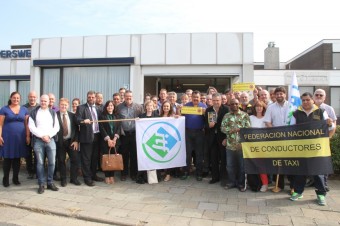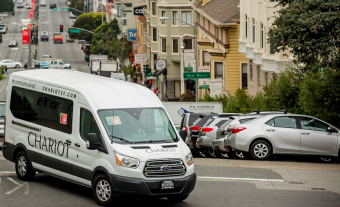Karhoo crashes after takeover talks collapse
“It is with much regret that we have to announce that Karhoo has had to close its service and is now looking at the next steps for the business”, taxi comparison and booking app Karhoo announced yesterday. Karhoo is shutting down after only six months in operation in the British capital, and just weeks after it claimed to have overtaken Uber as London’s leading taxi app. Yesterday Sky News reported Karhoo was still battling to avoid crashing into administration: “The high-profile taxi-booking app is engaged in a race for new cash as it fights to stave off bankruptcy.”
The UK magazine Professional Driver reports that the closure of the company comes after the failure of an attempt to raise further capital from a private investor to stop it from going into administration. Staff have already been made redundant, as the Karhoo app has stopped functioning. It is unclear whether administrators have been appointed or not, in which case the assets could be snapped up by a rival app provider.
In a statement, Karhoo announced also: “The Karhoo staff around the world in London, New York, Singapore and Tel Aviv have, over the past 18 months, worked tirelessly to make Karhoo a success. Many of them have worked unpaid for the last six weeks in an effort to get the business to a better place.”
“Unfortunately, by the time the new management team took control last week, it was clear that the financial situation was pretty dire, and Karhoo was not able to find a backer. “We would like to thank our staff, our partners, the fleets around the world that shared our vision, and the hundreds of thousands of people who downloaded the app and supported what we were trying to do. The world needs a Karhoo.”
At the beginning of 2015 the groundwork for Karhoo was laid by Daniel Ishag. The app launched in London on May 9, 2016, and has since been rolled out into a number of other UK cities including Manchester, Birmingham and Leicester. It offered a similar click-and-hail functionality to Uber, but worked with established private hire fleets rather than individual drivers, and offered a number of extra features, including price comparison and the ability to pre-book. The roll-out in the US, in Singapore and in Europe was planned for later this year and the beginning of 2017.
Karhoo has always stated it would only work with licensed operators and as such it was exactly what some operators in the taxi and PHV industry were waiting for. There were also others, who feared it would become the Booking.com of taxis and start dictating prices and increase percentages. Some operators, particularly in Europe, where the app was not established yet, feared Karhoo would be poaching ‘their’ work instead of giving them another stab at a market already being lost to Uber et al.
In the UK some of the biggest London operators signed up, including Addison Lee, Keen Group, GLH, Swiss Cottage Cars and eConnect Cars, as well as black cab operator ComCab. Also in the rest of the country Karhoo proved very popular.
At an impressive informal pre-launch party for many of the signed-up UK operators at the top floor of the London ‘Cheesegrater’ office building earlier this year, the enthusiasm of all UK taxi and private hire fleets was palpable. Most of them were rearing to go with the app which many saw as a lifeline for the established taxi and PHV-industry and a powerful ally against Uber.
In May, founder Daniel Ishag launched Karhoo with a flourish, claiming: “We are levelling the playing field for hundreds of thousands of licensed drivers through our fleet partnerships and giving them the chance to fight back while at the same time offering customers more choice. We are giving hundreds of thousands of Davids the power and platform to take on Goliath.” Ishag told Professional Driver in April that Karhoo was “a natural evolution of the Uber system” and said Karhoo would be “spending millions and millions of pounds on marketing” in a bid to compete with the US-based app.
In October, Karhoo revealed figures for its first three months of operation in London. It claimed to have more cars in the capital than any other cab app, including Uber, and a weekly turnover of £750,000. The app was processing up to 7,000 bookings a day, Karhoo said. Inventory had risen to 33,000 cars in London and 110,000 across the UK. More than 140,000 UK users have downloaded the app and registered.
But the initial funding – one pre-launch Financial Times article mentioned (unconfirmed) initial financing to the tune of £ 250 million – appears to have run out, leaving Karhoo unable to pay suppliers and staff. According to reports, Karhoo staff received a memo last week explaining that a new backer was in talks to save the business. But the memo said the potential backer had sought “reassurances about the state of the business, as he is being asked to invest money today with no due diligence done”, the memo said. Karhoo told the staff terms were “very close to being acceptable”, though “a new hoop was thrown in the way” and this seems to have derailed the deal, despite a pledge by members of Karhoo’s management to put $600,000 of their own money into the business.
The same operators who Karhoo welcomed in one of London’s tallest office buildings at the beginning of the year, will be devastated by the collapse. Some London firms said Karhoo had been a lifeline in the battle with Uber. Nadeem Khan, who runs Cascade Cars in Wimbledon, told Professional Driver in October: “We were seeing a lot of our jobs go to Uber, but now they are coming back to us through Karhoo. The difference is that Karhoo is helping the industry while others are trying to take it over.”
Nicholas Monteith, owner of private hire firm Mornington Cars, said: “Without doubt, Karhoo is a lifesaver for the classic, licensed minicab driver. It will help protect the minicab industry and allow us to fight back, bringing us jobs that we would otherwise not have been able to access, giving us the chance of more work while giving consumers more choice. It allows us properly to compete.”
It seems that the Israel R&D office and the New York office closed well before the news was announced in London. Only recently Karhoo was the main (and lavish) sponsor of the Annual Meeting of the International Association of Transportation Regulators (IATR) in San Francisco (September 22-25) in preparation for a successful roll-out of the app in the US later this year.
“Karhoo’s financial travails come amid frenzied competition in the market for booking private car journeys on mobile phones and other digital devices”, comments Sky News. “Uber has raised more money than any other start-up company in history, and is now valued at more than $65bn. In Europe, Hailo is merging with MyTaxi following a major investment from Daimler, the German owner of Mercedes-Benz, as taxi-booking apps seek greater scale to compete. It was unclear how much additional funding Karhoo requires to have a viable future.” In the staff memo sent yesterday, Karhoo employees were informed that work was underway to secure new investment but were not told the identity of the potential new backer.
Interestingly, the troubles at Karhoo somehow put the IRU’s UpTop group of licensed and certified apps back in the limelight. After its inception, about two years ago, the initial idea to connect all UpTop-apps and make worldwide roaming possible, stalled for technical reasons. At the last IRU Taxi Forum, last weekend in Cologne, the IRU promised to “invest heavily in building a ‘Taxi Cloud’” and in the UpTop roaming capability. The UpTop-apps now connect 500.000 taxis, 12% of the world’s estimated 4,5 million taxis.
- Who will step in? Many operators will miss Karhoo as a lifeline to often elusive work.









